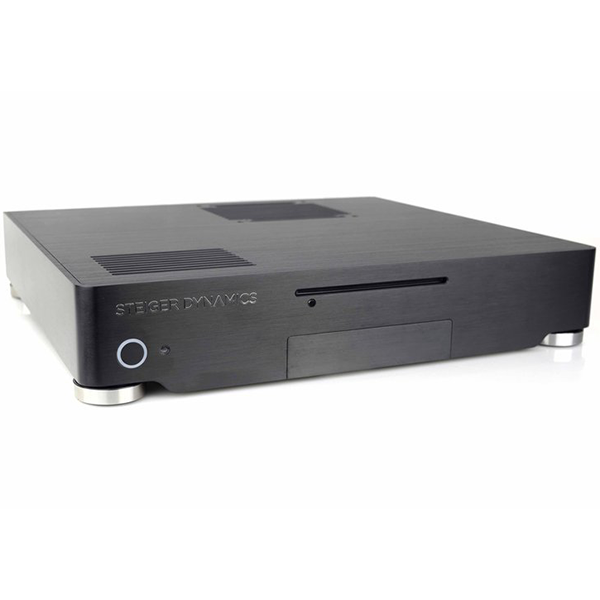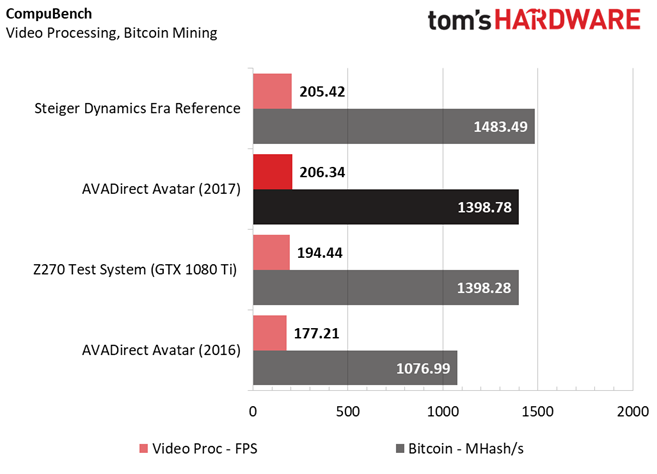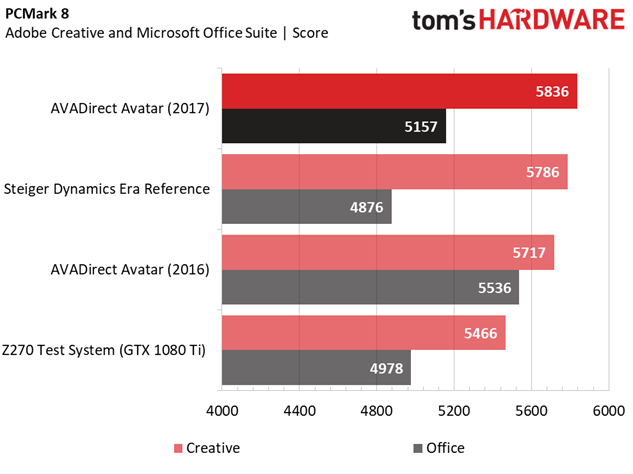AVADirect Avatar 2017 Desktop Review
Why you can trust Tom's Hardware
Synthetic & Productivity Benchmarks
For comparison, we turn to our Z270 reference system, which features an Intel Core i7-7700K (clocked at its stock 4.2 GHz with a 4.5 GHz max turbo frequency in lightly threaded applications) in an ASRock Fatal1ty Z270 Gaming i7 ATX motherboard. A 16GB (2x8GB) kit of Kingston HyperX Savage DDR4-2133 memory runs at the standard CAS latency of 15-15-15-36, and EVGA provided us with a set of the Founder’s Edition graphics cards (a GTX 1080 Ti, 1080, and 1070) and a 1000W PSU. We used data from the GTX 1080 Ti for this review, and we run the GPU at its respective default base and boost clock frequencies. You can check out the full specifications of our test rig below.
Comparison Products
Test System Configuration
We also included data from our recent review of the Steiger Dynamics Era Reference gaming desktop, which sports the same GPU as the AVADirect Avatar (a Founder’s Edition GTX 1080 Ti), and which Steiger overclocked (for an added $50) by 120 MHz on the core clock and by 200 MHz on the memory clock. AVADirect doesn’t offer GPU overclocking services on its Avatar series desktops (although it does offer the service on other models for $25), with the EVGA GeForce GTX 1080 Ti Founder’s Edition graphics card running at its stock base, boost, and memory clock frequencies (1480 MHz, 1582 MHz, 11 GHz, respectively), similar to our test rig.
Steiger’s system also features an overclocked Core i5-7600K, which is boosted up to 4.8 GHz with a low-profile air cooler. The Avatar sports a liquid-cooled Intel Core i7-7700K overclocked to 4.7 GHz, and we should see it prevail against the Era in games and applications where hyperthreading is advantageous. However, the Era could pull ahead in workloads that rely on single-threaded performance.
Last but not least, we compared the new AVADirect Avatar to its predecessor, the 2016 Avatar. At the time, it was equipped with a Core i7-6700K overclocked to the same 4.7 GHz as the new Avatar (with a Core i7-7700K). It also had the same 16GB (2 x 8GB) kit of Kingston HyperX DDR4-2400 memory (with a CAS latency of 15-15-15-35). However, the top dog in the GPU kingdom at the time was the GTX 1080, so the old version will undoubtedly fall behind in graphics-intensive workloads against the new version’s GTX 1080 Ti.
Similarly, the older model had a 500GB Samsung 850 EVO SATA SSD, whereas the new Avatar 2017 is equipped with a 256GB Samsung 960 Evo M.2 NVMe SSD. This is a significant shift in components from the previous model; AVADirect didn’t even offer M.2 SSDs (NVMe or SATA) in its Avatar configurations at the time. Furthermore, the old version had a 120mm liquid cooler, but the new AVADirect Avatar features a 240mm radiator (and only if you opt to overclock the CPU). Comparing the Avatar 2017 ($2,677) against the older 2016 Avatar ($2,509) should show if AVADirect has improved the overall value of its product over time.
3DMark


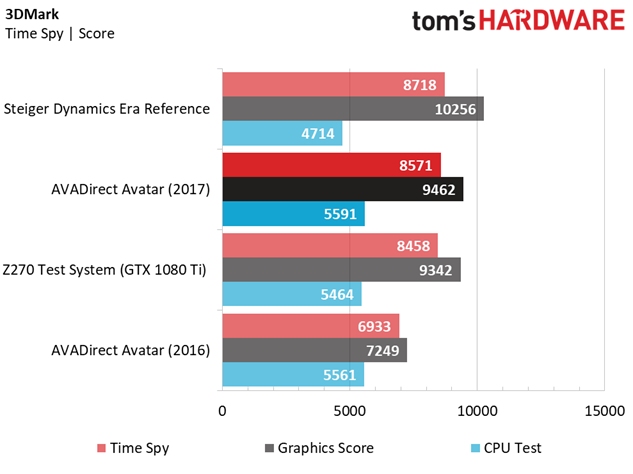
The AVADirect Avatar manages a better overall score against our stock-clocked GTX 1080 Ti-equipped test rig throughout the 3DMark Fire Strike and Time Spy benchmarks, thanks primarily to its higher Physics score; a result of the CPU overclock. The Graphics scores come in slightly ahead of our test rig; these two systems should be neck and neck in graphics-intensive workloads throughout our benchmark suite, considering they sport the same GPU and clock rates.
As the graphics power demand increases with Fire Strike Extreme and Ultra, we see the Steiger Dynamics Era Reference upend the Avatar’s overall score, which is not surprise given the moderate GPU overclock Steiger applied to its Founder’s Edition graphics card. However, the Avatar goes unchallenged in the Physics (Fire Strike) and CPU (Time Spy) tests thanks to its moderately overclocked and hyperthreaded Core i7-7700K.
Get Tom's Hardware's best news and in-depth reviews, straight to your inbox.
Cinebench R15
The Avatar can’t quite catch up to the Era’s single-threaded performance in the Cinebench R15 rendering tests due to the 100 MHz difference in CPU clockrate (Steiger overclocked to 4.8 GHz, whereas AVADirect went for stability with 4.7GHz), but it pulls far ahead of Steiger’s pricier GTX 1080 Ti-equipped offering as soon as hyperthreading becomes a factor in the multi-threaded and OpenGL tests,. The new Avatar also easily bests our test rig’s stock-clocked CPU, and its predecessor’s Core i7-6700K falls the slightest bit behind the new version’s i7-7700K at the same 4.7 GHz clockrate. However, the OpenGL framerates are identical between the battling Avatars, showing that there isn’t much of a difference between Skylake and Kaby Lake processors clocked at the same frequency in this particular workload.
CompuBench
The Avatar manages to outpace our Z270 test rig in the CompuBench Video Processing test thanks to its CPU overclock, but it falls behind the Era ever so slightly thanks to Steiger’s higher overclock. Steiger’s GPU overclock also outpaces the Avatar’s stock-clocked GTX 1080 Ti Founder’s Edition graphics card in the Bitcoin Mining test, but the Avatar bests our test rig in this GPU-bound portion of the benchmark, albeit by a narrow margin.
Storage Test
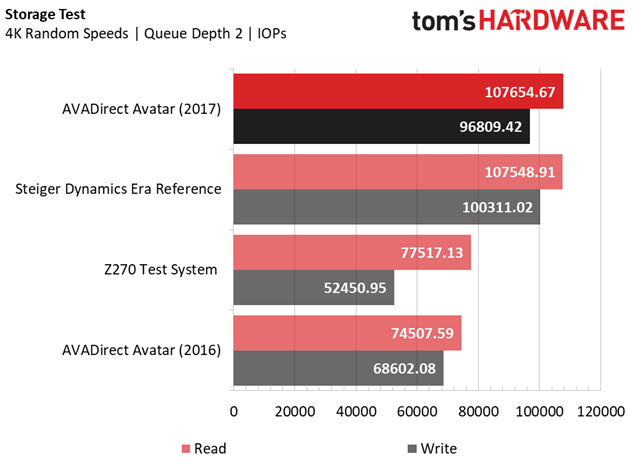
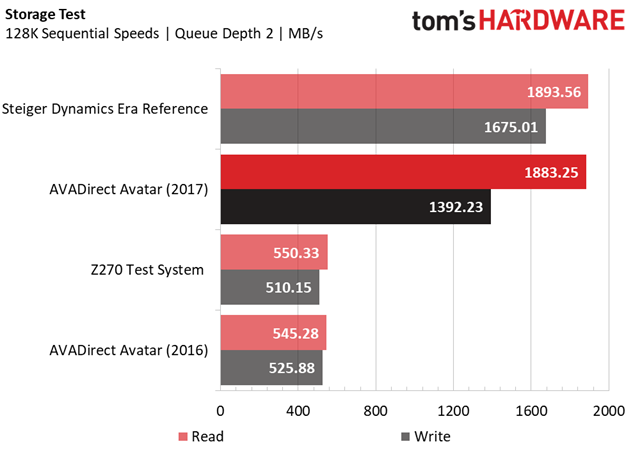
The Avatar’s 250GB Samsung 960 EVO M.2 NVMe SSD is a potent storage device, with sequential read and write speeds reaching over 1800 MB/s and 1300 MB/s, respectively. The Steiger’s nearly identical SSD (a 500GB Samsung 960 EVO) barely edges out the Avatar in sequential read performance, but it pulls ahead of it in sequential write performance thanks to its higher capacity (which usually provides better write speeds).
Random 4K read performance is similar; the Avatar and Era are again neck-and-neck, with the AVADirect submission getting the win by a small margin. However, write speeds take a similar dive in performance compared to the Era’s higher-capacity SSD. Despite the second-place write performance finishes, these speeds are still insanely fast for single-SSD (non-RAID) primary storage, and decidedly faster than the former version of the Avatar, which could only be equipped with SATA SSDs at the time.
Sandra Memory Bandwidth

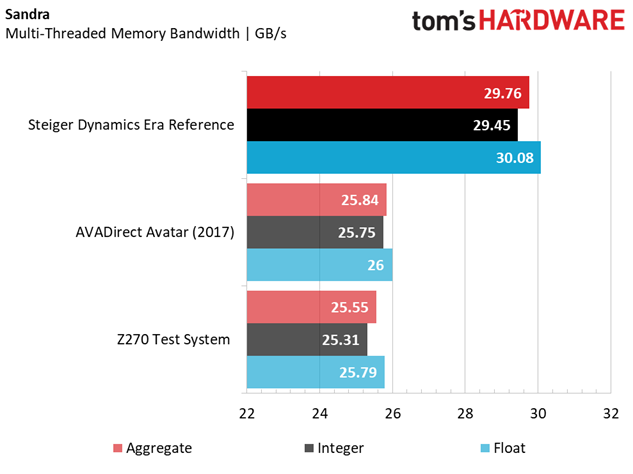
The AVADirect Avatar offers above-average total memory bandwidth compared to our test rig’s memory set at the DDR4 standard of 2133 MHz (with a CAS latency of 15-15-15-36). The Avatar’s 16GB (2 x 8GB) kit of DDR4-2400 maintains those same timings at a higher frequency, so it’s no surprise we see a boost of performance there. However, it’s not as fast as Steiger’s choice of DDR4-3000, which easily bests the lower-speed memory.
We didn’t run the Sandra Memory Bandwidth tests in our Z170 reviews, so we don’t have performance data from the 2016 version of the Avatar. However, we’d imagine it would be extremely similar to the current iteration’s performance, given that the memory options (brand, speeds) have not changed since our last look at the system.
PCMark 8
The AVADirect Avatar finishes our productivity suite with top scores, besting the Steiger Dynamics Era Reference by small margins in both the Adobe Creative and Microsoft Office application tests in PCMark 8. Hyperthreading plays a pivotal role in these results, evidenced by the lead our Z270 test rig (with a hyperthreaded Core i7 CPU) has against the Era (with a non-hyperthreaded Core i5 processor) in the Office portion of the test, despite the 300 MHz CPU clock rate difference between the two. As a result, the Avatar still manages to beat out its similarly equipped and higher overclocked competition.
Incidentally, last year’s version of the Avatar completely dominated the other system in the Office application benchmark. This can likely be attributed to recent upgrades to both Microsoft Office and PCMark8, which could affect scoring. Without a way to retest the old version of AVADirect’s gaming PC, we can at least confidently say the Avatar bests the field in the PCMark 8 tests (either way).
MORE: Best PC Builds
MORE: How To Build A PC
MORE: All PC Builds Content
Current page: Synthetic & Productivity Benchmarks
Prev Page Introduction & Product Tour Next Page Gaming BenchmarksDerek Forrest was a contributing freelance writer for Tom's Hardware. He covered hardware news and reviews, focusing on gaming desktops and laptops.
-
Dogbites For the price tag of over $2,600, this is completely ridiculous. I don't know why anyone would pay that for this. I just recently built a system for half this price just about that is far superior in most area's.Reply
1) I used the 6700k - it only slightly slower but the problem with the 7700 is you can only use Windows 10 with it. I wanted option & the 7700 gives you known.
2) NMVE 512 M.2 hard drive with a 480 gig ssd & 60 ssd
3) Noctua d15 air cooler, I have used the h100 twice before and the D15 is just as good if not better
4) Dual blu-ray dvd burners
5) Asus 270e Strix - wifi and blue tooth
6) dual video cards. I went with 2 970's ( I got them pretty cheap )
7) 1000 watt power supply
8) 16 gig of ddr 4
Built for less then $1,350. Half of what they want with higher performance. -
NoviceNob DOGBITES: That's great that you built 'a better' machine for less. But why should anyone buy this unit? Because they can't build it themselves. And don't go saying, "it's so easy crap." It's not. And for the price? AVADirect has to make a profit too. You know what the employees are saying about how much you paid for your computer parts? Their saying, he paid a ridiculous price for those parts. It's all relevant. Enjoy your new computer.Reply -
NoviceNob DOGBITES: That's great that you built "a better" unit. And why should anyone buy the Avatar 2017? Because they can't build one (and don't give me this, "it's so easy crap"), and AVADirect has to make a profit. Just like all those companies that you bought from. If you knew what employees paid for the same thing you bought, you'd be wondering why you paid 'so much'. Best of luck with your new machine. :)Reply -
LilDog1291 Reply20170553 said:DOGBITES: That's great that you built "a better" unit. And why should anyone buy the Avatar 2017? Because they can't build one (and don't give me this, "it's so easy crap"), and AVADirect has to make a profit. Just like all those companies that you bought from. If you knew what employees paid for the same thing you bought, you'd be wondering why you paid 'so much'. Best of luck with your new machine. :)
Ok but the problem is that they are creating a huge markup on the consumer pricing of the parts (which they are most certainly not paying) and making the PC gaming market expensive to enter into and causes some interested potential future PC enthusiasts turn away in favor of a console.
So here is their EXACT same parts list if you were to purchase it yourself: https://pcpartpicker.com/list/ymZKwV
It comes in at $1888.85
So their price is $2677 at this configuration. That is almost a 42% markup at consumer pricing, which again, they are not paying. So its safe to say they are most likely making 55-65% per system sold on parts alone. Now again they probably have rent and employees to pay, but I can't think of very many other businesses that make this much profit per unit sold. Its just robbery, plain and simple. -
c4s2k3 Reply20170652 said:20170553 said:DOGBITES: That's great that you built "a better" unit. And why should anyone buy the Avatar 2017? Because they can't build one (and don't give me this, "it's so easy crap"), and AVADirect has to make a profit. Just like all those companies that you bought from. If you knew what employees paid for the same thing you bought, you'd be wondering why you paid 'so much'. Best of luck with your new machine. :)
Ok but the problem is that they are creating a huge markup on the consumer pricing of the parts (which they are most certainly not paying) and making the PC gaming market expensive to enter into and causes some interested potential future PC enthusiasts turn away in favor of a console.
So here is their EXACT same parts list if you were to purchase it yourself: https://pcpartpicker.com/list/ymZKwV
It comes in at $1888.85
So their price is $2677 at this configuration. That is almost a 42% markup at consumer pricing, which again, they are not paying. So its safe to say they are most likely making 55-65% per system sold on parts alone. Now again they probably have rent and employees to pay, but I can't think of very many other businesses that make this much profit per unit sold. Its just robbery, plain and simple.
First, let me state that I also prefer to build my own. I happen to enjoy it. That said, you are talking about $800 or so differential on the price of components alone but you are ignoring:
1) It should take several hours of your time to order the parts, assemble, manage cabling, install OS and software, and stability test your system. I don't know what $$ value you place on your own time, as that is indeed an individual assessment. For some, spending 2-4 hours of their own time is worth several hundred $$. And, BTW, claiming you can assemble it in 30 minutes is not an adequate answer as most people know enough to not rush something like a system build.
2) As a builder, you assume all risk associated with acquiring all the components from whatever sources, assembling all those pieces, verifying they all work individually and as a system, installing software, drivers, and everything else to actually make the damn thing works. If you put it all together and for whatever reason it does not post or otherwise malfunctions, you eat it. It's more of your time to diagnose and fix. A pre-built system like this one incurs no such risk. That is likewise worth $$$ to many.
I believe just (1) and (2) above close a great deal of that $800 gap pretty quickly for a lot of people. As much as I may like tinkering with computer components, I understand the value proposition of a system like this one, and why someone who wants to game might opt to acquire it. -
Luis XFX C4S2K3 Is right, for someone who is in a profession of some kind who makes plenty of money, the savings of a few hundred bucks over your time, effort, and the end result levels things out. I have been building systems since 1997, and I'm now at the point in my life where buying a prebuilt system is what I'll likely do from now on, I would rather spend time gaming than putting together systems and tweaking them.Reply -
Rob1C LILDOG1291 Said:Reply
It comes in at $1888.85. ... So their price is $2677 at this configuration. That is almost a 42% markup at consumer pricing, ... Its just robbery, plain and simple.
I live in North America. Back in the day when I was a Tech we made 15%, so your looking at $2,172.18 (using your numbers and parts source, and their Warranty).
Our company also made Preconfigured Systems, half a dozen choices and you could swap out something like a Video Card or HD; we offered a 3 year Warranty (at the time IBM offered a 4 year Warranty and charged twice as much, others offered a 2 year and charged 5 to 15% more).
Work went offshore and people bought whatever it came as from whoever made it, 1 year Warranty and a bit cheaper than us - why that made sense I dunno; I told people at the time their options (don't be a fool) but some knew better and what you see today is what you get.
I'd pay that for an HP (still made you know where) but at least it wouldn't have faux pleather and odd wires exposed in the window.
We made our money on quality and moderate volume (for a smallish company) but it was not much different at one of the biggest assembler/reseller businesses where I also worked (except they paid ridiculously little).
Yes, price is too high. -
punx223 Reply20169524 said:For the price tag of over $2,600, this is completely ridiculous. I don't know why anyone would pay that for this. I just recently built a system for half this price just about that is far superior in most area's.
1) I used the 6700k - it only slightly slower but the problem with the 7700 is you can only use Windows 10 with it. I wanted option & the 7700 gives you known.
2) NMVE 512 M.2 hard drive with a 480 gig ssd & 60 ssd
3) Noctua d15 air cooler, I have used the h100 twice before and the D15 is just as good if not better
4) Dual blu-ray dvd burners
5) Asus 270e Strix - wifi and blue tooth
6) dual video cards. I went with 2 970's ( I got them pretty cheap )
7) 1000 watt power supply
8) 16 gig of ddr 4
Built for less then $1,350. Half of what they want with higher performance.
Comparing apples to oranges on older parts you can now get cheaper is not really a good way to prove a point... but to each their own.. -
punx223 Reply20170652 said:20170553 said:DOGBITES: That's great that you built "a better" unit. And why should anyone buy the Avatar 2017? Because they can't build one (and don't give me this, "it's so easy crap"), and AVADirect has to make a profit. Just like all those companies that you bought from. If you knew what employees paid for the same thing you bought, you'd be wondering why you paid 'so much'. Best of luck with your new machine. :)
Ok but the problem is that they are creating a huge markup on the consumer pricing of the parts (which they are most certainly not paying) and making the PC gaming market expensive to enter into and causes some interested potential future PC enthusiasts turn away in favor of a console.
So here is their EXACT same parts list if you were to purchase it yourself: https://pcpartpicker.com/list/ymZKwV
It comes in at $1888.85
So their price is $2677 at this configuration. That is almost a 42% markup at consumer pricing, which again, they are not paying. So its safe to say they are most likely making 55-65% per system sold on parts alone. Now again they probably have rent and employees to pay, but I can't think of very many other businesses that make this much profit per unit sold. Its just robbery, plain and simple.
Did you plan to actually add all of the parts the review listed? you have no HDD, no memory... im sure theres more... but I clicked your link out of interest...
I am disappoint. :/
EDIT: I went ahead and updated this as I found that your motherboard is incorrect.... No added led system...
this is not including the fact that should you have an issue a company is going to support you and help make things right and fix it for you... whereas building your own you support everything yourself.
So now while that may not add value to you... there is inherent value in all of this especially your deceptively low PCPartpicker listing which is not even complete.

